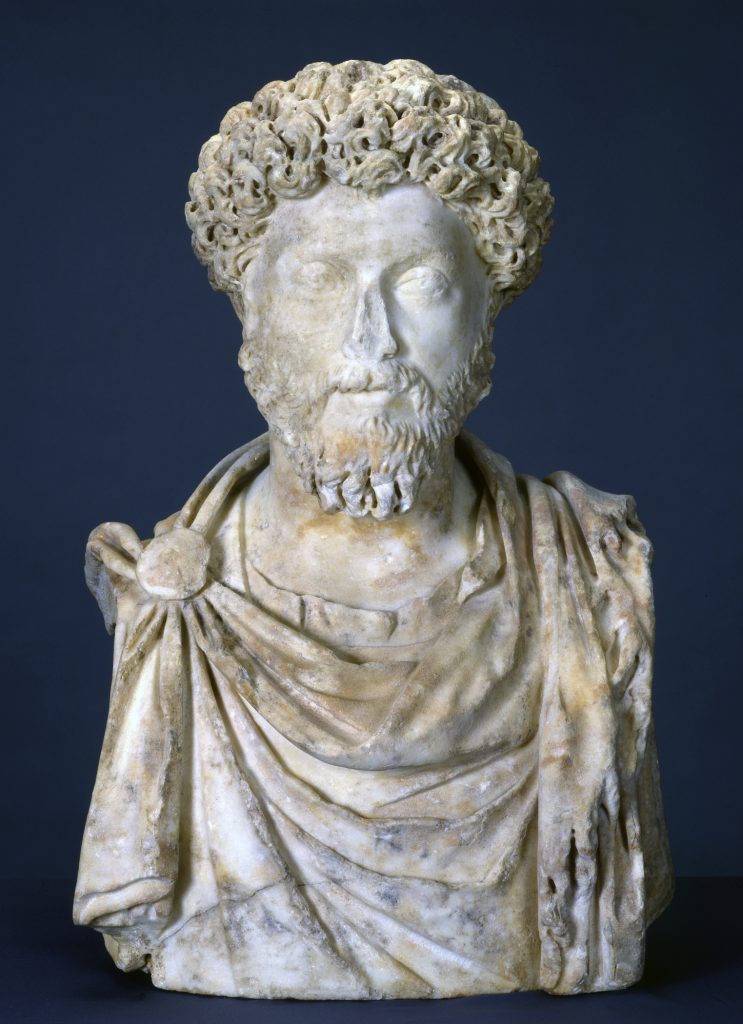Portrait of the Emperor Marcus Aurelius (work of art)
Artwork Info
Key Ideas
- This sculpture is a marble portrait of Marcus Aurelius, who ruled the Roman Empire from 161 to 180 C.E. He was considered to be a “good emperor” who helped bring peace and unity to the Roman Empire.
- Marcus Aurelius dedicated his life to the Greek philosophy of Stoicism. This school of philosophy encouraged a calm lifestyle, even in stressful situations. The emperor wrote his Stoic ideas in his personal diary, and it was later published as a collection of books.
- The portrait depicts Marcus Aurelius as a philosophy king. He has the beard of a traditional Greek philosopher. His eyes are lightly carved, which gives him a thoughtful facial expression.
- Marcus Aurelius was a successful military leader. This sculpture portrays him wearing garments that show his status as a powerful general.
- His hair and beard were created using a Roman drill.
Learn More
Marcus Aurelius ruled the Roman Empire from 161 to 180 C.E. He was the last of the five “good emperors” of the second century. After a long period of war, these five emperors brought some peace and unity to the Roman Empire. Marcus Aurelius’s success as a military leader is represented by the garments he is wearing in this portrait. The bottom layer is a tunic (a type of undergarment) that is visible on his upper chest. Above the tunic he is wearing a cuirass, or breastplate. This is indicated by the vertical line that runs along the neckline of his tunic, on the right side. The top layer is a paludamentum, a long cloak that was often worn by Roman military leaders. The cloak is secured in place and pinned at the right shoulder.
Marcus Aurelius was a devoted follower of the Greek philosophy of Stoicism. The school of Stoicism was founded by Greek philosopher Zeno in 300 B.C.E. It taught people to accept the world as it is and to live with it in a calm and peaceful way. It also encouraged its followers to have self-control. When Marcus Aurelius was fighting in the First Marcomannic War against the Germanic and Sarmatian tribes (approximately 170 to 175 C.E.), he found strength in the principles of Stoicism. He wrote his stoic views on death, war, and fame in his diary. His writing indicates that he studied the burden of power and wanted to live his life in harmony with nature. His diary was later published in a collection of 12 books titled Meditations.
This sculpture depicts Marcus Aurelius as a wise and mature man with a passion for philosophy. His eyes are lightly carved, which gives him a strong yet thoughtful expression. His beard (similar to that of his adopted grandfather, the emperor Hadrian) follows the tradition of the “bearded Greek philosopher.” The deep shadows in his hair contrast with the smooth surface of his face. The dense curls and locks of his hair and beard were created with a Roman drill. This long metal tool with a cutting end was attached to a shaft with a wooden handle. A cord wrapped around the shaft several times. In order to use the drill, one person had to move the shaft by pulling back and forth on the cord while another person applied pressure on the handle. This process resulted in holes and channels in the stone that created depth and detail in fragile areas of the sculpture.
tags: texture, proportion, power, identity, observation, ancient Rome
Additional Resources
Resources for Teachers:
- Read a short essay about the life of Marcus Aurelius.
- Explore a website about stoneworking in antiquity.
- Read an article about Roman portrait sculptures.
Resources for Students:
- View a bronze statue of Marcus Aurelius.
- Watch a video about ancient Roman portraits and discover what they reveal about Roman history.
- Watch a video about the philosophy of Stoicism.

